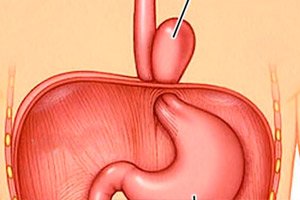
All iLive content is medically reviewed or fact checked to ensure as much factual accuracy as possible.
We have strict sourcing guidelines and only link to reputable media sites, academic research institutions and, whenever possible, medically peer reviewed studies. Note that the numbers in parentheses ([1], [2], etc.) are clickable links to these studies.
If you feel that any of our content is inaccurate, out-of-date, or otherwise questionable, please select it and press Ctrl + Enter.
Sliding esophageal hernia
Medical expert of the article
Last reviewed: 08.07.2025

In case of diaphragmatic hernia or hernia of the esophageal orifice of the diaphragm, the diagnosis can be formulated as sliding hernia of the esophagus. Obviously, the simplified name, which has a descriptive nature, is more understandable to patients.
Different names, same pathology
Sliding hernia of the esophagus, diagnosed in 90-95% of cases of hiatal or diaphragmatic hernia (hiatus esophageus is the Latin term for the esophageal opening of the diaphragm), is the same as axial or axial hernia of the esophagus (axis in Latin means axis). [ 1 ]
And the essence of this disease is that the part of the esophagus located in the abdominal cavity (cavitas abdominis), and even part of the stomach (in particular, its upper cardiac section with the lower esophageal sphincter) slip through the esophageal opening of the diaphragm, moving into the chest cavity (into the posterior mediastinum), and then - if the patient changes body position - again descends into the abdominal cavity. [ 2 ]
Etiology, pathogenesis, symptoms, diagnosis and main methods of treatment are covered in detail in the publications:
- Esophageal hernia: causes, symptoms, how to treat?
- Signs of a hiatal hernia
- Endoscopic signs of esophageal hernia
So, despite the different names used by gastroenterologists, this is one and the same pathology of the gastrointestinal tract.
It is worth emphasizing once again the importance of such risk factors for the development of axial or sliding hernia of the esophagus as old age (with shortening of the esophagus and weakening of the muscle tone of the sphincters, which leads to their expansion) and obesity. Moreover, this is a visceral or abdominal type of obesity, in which, as experts note, the formation of gases in the intestine increases, which causes an increase in pressure in the abdominal cavity (intra-abdominal hypertension). In turn, this increases the pressure on the stomach, "pushing" it upward and weakening the lower esophageal sphincter, which causes gastroesophageal reflux.
How does sliding hiatal hernia affect the heart?
This question often arises because an axial or sliding hernia of the esophagus can mimic the symptoms of a heart attack in the form of aching pain felt in the left part of the mediastinum (where the heart is actually located), which, when intensified, can radiate to the left shoulder or scapula - as in angina pectoris.
However, this symptom of a hiatal hernia is not etiologically related to cardiology. Angina with chest pain during physical exertion occurs due to insufficient blood supply to the heart muscle - myocardial ischemia, which is a consequence of atherosclerosis of the coronary arteries.
And with a hernia, pain behind the breastbone, which begins some time after eating and intensifies in a lying position, is explained by two factors:
- irritation of the branches of the vagus nerve, passing through the mediastinum along the surface of the esophagus to form the esophageal plexus;
- damage to the lower esophageal sphincter and the mucous membrane lining the esophagus under the influence of acid reflux and developing (in almost 20% of cases) gastroesophageal reflux disease.
Electrocardiography (ECG) helps differentiate myocardial ischemia and hiatal hernia. [ 3 ]
Diet for sliding hernia of the esophagus
The intensity of manifestation of axial (sliding) hernia of the esophageal opening can be corrected by reducing body weight and changing the diet. [ 4 ]
Detailed information about nutritional features and the optimal diet for this pathology, as well as prohibited and recommended products in the materials:
Diet for esophageal hernia: menu for every day, recipes
Exercise therapy for sliding esophageal hernia
Part of the treatment also includes therapeutic exercise for esophageal hernia, the purpose of which is to strengthen the muscle that separates the abdominal and chest cavities – the diaphragm.
What exercises for sliding esophageal hernia, including breathing exercises, are recommended by exercise therapy specialists, are detailed in the publication - Effective exercises for esophageal hernia.

